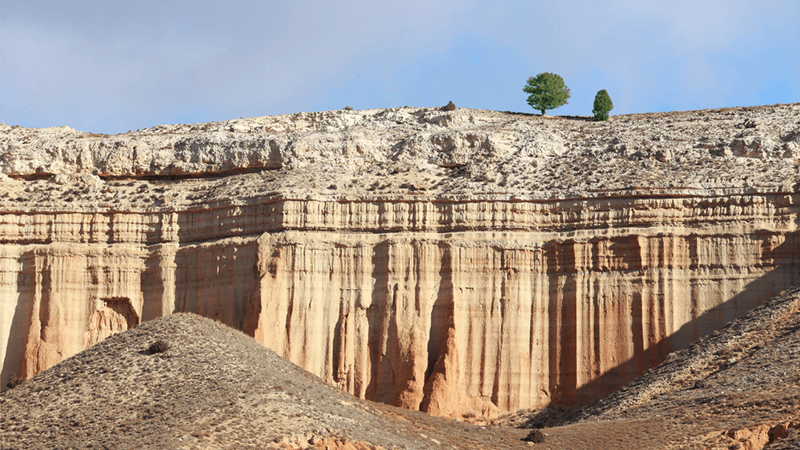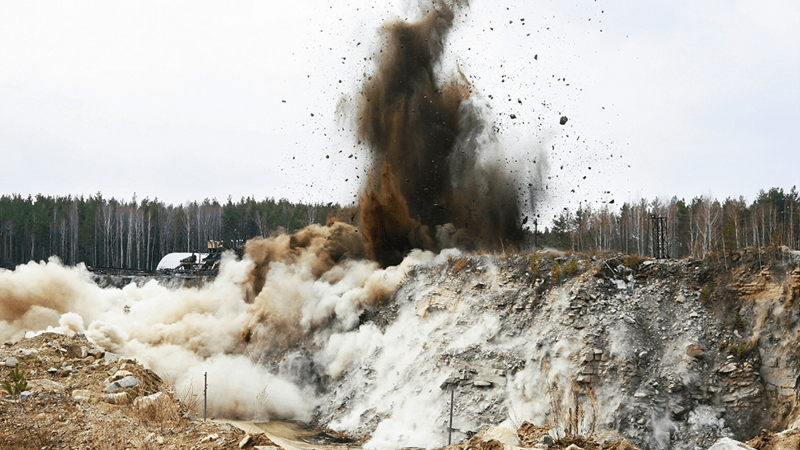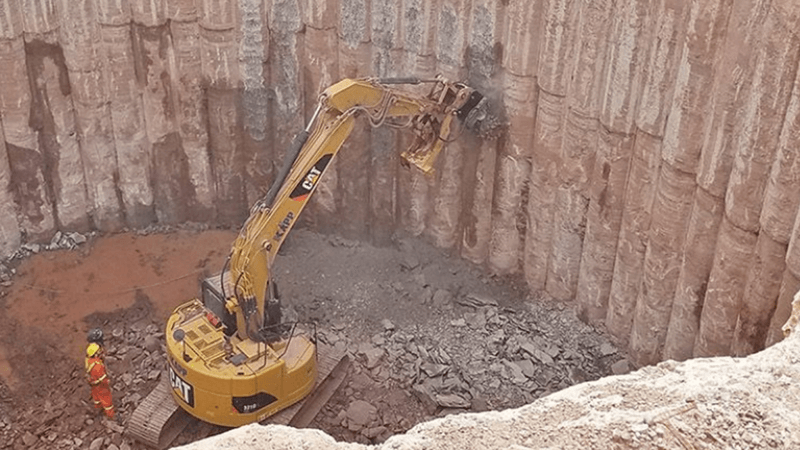What Sedimentary Rock Is Easiest to Excavate?

Hitting a layer of rock during excavation can either be a minor hiccup or a major headache, depending on the type of rock beneath your site.
So, what sedimentary rock is easiest to excavate? The short answer is sandstone. Known for its softer, granular structure, sandstone allows equipment like a rock grinder attachment to cut through it with minimal hassle, making it a preferred choice in many construction projects.
This blog will highlight the characteristics that make sandstone so excavation-friendly, compare it to other rock types, and offer practical insights to help ensure your next project stays on track.
Key Takeaways
- Sandstone, chalk, and shale are the easiest sedimentary rocks to excavate due to their soft, granular structure.
- Proper tools like rock grinders and hydraulic attachments make sedimentary rock excavation faster and more efficient.
- Factors like depth, water, and weathering can impact the ease of sedimentary rock excavation, requiring careful planning.
Excavating Different Types of Rock: What You Need to Know
The success of an excavation project depends on the type of rock lying beneath the surface. Each rock type—whether sedimentary, metamorphic, or igneous rock—presents its own set of challenges.
To ensure your project goes off without a hitch, it’s crucial to understand these differences and how they impact the excavation process.
Sedimentary rocks: Easier to excavate
Formed from compacted layers of sand, silt, and other materials, sedimentary rocks are naturally softer and less dense.
Sandstone, a prime example, is particularly easy to break apart thanks to its granular structure. This means that tools like a rock grinder attachment can slice through sedimentary rocks with minimal effort.
Igneous rocks: Tough and resistant
Born from cooled lava or magma, igneous rocks are incredibly hard and dense. Their high compressive stress makes them resistant to conventional excavation methods.
Tackling igneous rocks requires specialized equipment and, in some cases, blasting to break them down. If your project involves igneous rocks, be prepared for a more challenging—and costly—excavation process.
Metamorphic rocks: Unpredictable and tricky
Formed under intense pressure and temperature, metamorphic rocks can be unpredictable. They often shatter when drilled, thanks to their layered structure and hidden cracks.
Excavating metamorphic rocks demands precision and careful planning to avoid unexpected issues that could derail your project.
Which Sedimentary Rocks Are Easiest to Excavate?
Sedimentary rocks are the easiest to excavate, thanks to their softer structures formed from compacted layers of sand, silt, and organic material. Here’s a look at the top candidates for simple excavation.
Sandstone
Thanks to its loose, granular structure, sandstone breaks apart easily. Its softer composition allows tools like rock grinders to penetrate with little effort, making it a go-to for quick excavation, even at deeper levels.
Chalk
Soft and porous, chalk crumbles easily and rarely needs heavy equipment for removal. Formed from marine organisms, it breaks down quickly and washes away with ease, making it ideal for shallow digging and surface-level projects.
Shale
Shale's naturally layered structure, made of compacted mud and clay, allows it to split apart effortlessly. Basic tools are all that's needed to break through, and their existing cracks make excavation even easier.
Excavation Techniques for Sedimentary Rocks

Excavating sedimentary rocks tends to be a smoother process due to their softer composition compared to hard rocks like granite or slate.
Because sedimentary rocks are softer, they require less force to excavate, which lowers energy use and labor costs. This makes excavation more affordable and keeps projects on schedule. The right tools and techniques are key to getting the job done efficiently.
Here are the best methods for sedimentary rock excavation and why they work.
Skid Steer loaders and excavators
For large excavation jobs, heavy equipment like excavators and Bobcats are essential. These machines are designed to handle sedimentary rock efficiently, quickly digging through sandstone, chalk, or shale.
Equipped with attachments like rock grinders, they can break through the material with ease, saving both time and energy. Bobcats, with their compact size, are especially useful for projects that require maneuvering in tight spaces.
Hand tools for precision
For more detailed or delicate work, hand tools like hammers and chisels are the go-to option. These tools are great for breaking down smaller blocks of sedimentary rock or creating precise cuts in softer materials.
When necessary, drilling holes into the rock can make it easier to break larger pieces apart for removal.
Blasting
Although sedimentary rocks are generally easy to excavate, certain formations may be more tightly compacted and require blasting.
While rarely needed, blasting involves creating cracks in the rock structure using controlled explosives, breaking it into smaller sections for easier excavation.
Factors That Impact Sedimentary Rock Excavation
While sedimentary rocks like sandstone, chalk, and shale are easier to excavate than igneous rocks or slate, several factors still influence the process. Here’s what to consider:
Depth and location
Surface-level sedimentary rocks, such as shallow sandstone formations, are easier to dig through. But as you go deeper, the rock mass tends to become more compact, requiring more energy and stronger tools to excavate.
Deep sedimentary layers often need specialized equipment, like drill holes or more powerful attachments, to break through the ground.
Presence of water
When water seeps into sedimentary rock layers, it softens the material by weakening the cement that holds the rock together. This makes rock excavation easier but also cause issues like sinking or unstable ground conditions, which complicate construction.
You’ll need to carefully manage water presence to avoid disruptions or accidents during excavation.
Weathering
Weathering—both chemical and physical—breaks down rock structures over time.
Chemical weathering, caused by elements like rainwater and atmospheric chemicals, slowly breaks down rock structures, making them easier to excavate.
Physical weathering, like repeated freezing and thawing, also creates cracks in the rock, speeding up the digging process. Heavily weathered rock may be too fragile and may require careful handling to prevent collapsing structures.
Boulders and cracks
Pre-existing cracks in the rock can simplify excavation by creating natural weak points. However, large boulders embedded in the material may require extra effort to remove, slowing down excavation. Cracks also allow water to seep in, which further weakens the rock or causes drainage issues.
RockZone Americas: Your Solution for Easy Rock Excavation

Excavating sedimentary rocks like sandstone and chalk might seem simple, but challenges like compacted layers, depth, and water can make the job harder than expected. RockZone Americas specializes in hydraulic rock-cutting attachments and Rockwheel equipment designed to cut through sedimentary rocks efficiently, saving you time and reducing costs.
From deep rock masses to landscape projects, RockZone delivers tailored equipment solutions that meet your excavation challenges. We work closely with customers to ensure the right tools are in place, minimizing delays and enhancing efficiency. Call RockZone Americas today and simplify your next excavation project.
Summary
Sedimentary rocks like sandstone, chalk, and shale are the easiest to excavate due to their softer, less dense structures.
These rocks can be efficiently removed using tools like rock grinders or hydraulic attachments, which make them a top choice for construction, landscaping, and mining projects. Their ability to break apart with minimal force reduces energy usage and labor costs, making excavation faster and more cost-effective.
Identifying the rock type at your site is key to planning an efficient excavation. Using the right methods and equipment from RockZone Americas ensures your project stays on track and avoids costly delays, guaranteeing a smooth, efficient excavation process.
Frequently Asked Questions
Is conglomerate hard to excavate?
Conglomerate, a type of sedimentary rock made of rounded pebbles and larger rocks cemented together, can be more challenging to excavate than soft rocks like sandstone or chalk.
Its mixed composition makes it tougher and more resistant, requiring specialized tools like rock grinders or even drill holes to break through the rock mass efficiently.
Why is the extraction of minerals easy in sedimentary rock?
Mineral extraction is easier in sedimentary rock because these soft rocks, like sandstone and chalk, tend to be less dense and loosely compacted.
This allows for simpler digging and excavation, with minimal pressure needed to remove the rock material. The presence of natural cracks in sedimentary layers also facilitates easier access to minerals.
What is the best sedimentary rock for building?
Sandstone is considered one of the best sedimentary rocks for building. Its durability, ease of excavation, and ability to withstand weathering make it ideal for construction projects.
Sandstone blocks tend to maintain their structure well and are commonly used for foundations, walls, and other architectural elements.
What is the most useful sedimentary rock?
Limestone, a highly versatile sedimentary rock, is one of the most useful. It’s widely used in construction, as a key component in cement, and in various industrial applications.
Limestone’s soft structure makes it easy to excavate, while its chemical composition is valuable for producing building materials and industrial products.
